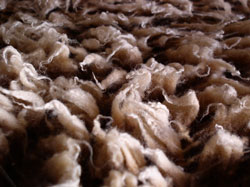An article
Return to
Articles
page
Washing fleece
Whether or not to wash a fleece is a personal choice, and there are spinners on both sides of the question who will insist that their own preference is the only way to go.
(I'm going to talk about this for a while because it's interesting, and some people can get quite huffy about it. ...Here's the best way to fight a huff: Inform yourself!)
We'll begin as close to the beginning as possible.
A little history
Here in Europe, the past is never too far beneath the surface; and I'd been curious what the traditions have been about washing wool. Scratch the surface -- and darned if the customs don't vary from place to place!
 In France, they seem to have always washed wool before spinning. Evidence of the practice during the Middle Ages appears in llustrations in medieval texts and in a wonderful series of stone figures in the cathedral of Chartres (left). The figure shown here is washing wool -- you can see the water streaming away behind her (click on the small image for a clearer view). Figures carved below her are busy carding the wool,
In France, they seem to have always washed wool before spinning. Evidence of the practice during the Middle Ages appears in llustrations in medieval texts and in a wonderful series of stone figures in the cathedral of Chartres (left). The figure shown here is washing wool -- you can see the water streaming away behind her (click on the small image for a clearer view). Figures carved below her are busy carding the wool,
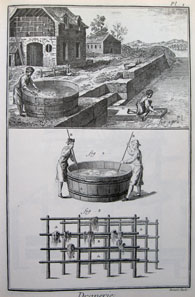 spinning it, and winding it into skeins.
spinning it, and winding it into skeins.
Throughout the Middle Ages, as far as we can tell from illustrations, wool washing was practiced much the same way at home and in industry (there was a large and lucrative wool industry in France at that time -- see the reading list below for more information).
By the late 18th century when King Louis XIV commissioned a work documenting all aspects of French artisanry and industry, wool washing was performed on a larger scale, but still mainly by hand -- and still using primarily cool water (right). The main wash for lifting mud and "suint" from the wool happens in the large vat; then the wool is placed in the pen in the river for a rinse. After washing, the sections of fleece are draped over rods to dry.
Meanwhile in Spain, wool was a valuable commercial commodity, and the techniques for washing the valuable merino fleeces were carried out on a grand scale. Those practices and their facilities were documented by a French wool trader who was deeply impressed by what he'd seen in his travels. The Spanish system involved enormous cauldrons housed in their own buildings and heated by fire. The heat would have been necessary to remove the rich oils present in merino fleeces.
In Holland, the climate is different, and so are the sheep; and the tradition has been to spin in the grease, then wash and dye the yarn afterwards. ...By the way, some modern Dutch wool-spinning equipment is still often geared for working with greasy fleece and will work better with that than with washed wool.
In Scotland, land of tartan and tweed, spinners would rinse the mud out of a fleece, but usually not take the extra step of scouring it. However, they also normally dyed "in the wool" before spinning, and the simmering dyepot would effectively clean a fleece as a side-effect of putting colour onto the fibre. Aged urine was often an ingredient in the dye bath, altering the solution's pH and contributing urea -- an excellent scouring assistant.
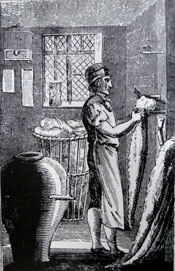
In England, the old professional guild system makes it hard to figure out what went on at the household level; but the professional guilds almost always worked with clean fleece. Professional wool-combers added oil to the fleece to aid combing partly because the natural oils had all been washed out before the wool arrived at their workshops.
Peter Teal, our present-day guru of woolcombing techniques, sums up his own reasons for washing wool prior to combing in his classic work, Hand Woolcombing and Spinning:
"I am strongly in favour of scouring the fleece, because not only is it more pleasant to handle, but the spinner has greater flexibility in the use of the basic raw material. Because the spinner has a constant supply of clean, dry fleece, to which is added the required amount of oil immediately prior to spinning, the raw material used has characteristics which are absolutely constant, month in, month out. Because the quality of the raw material never varies, touch need never vary and the chances of the yarn's being similarly uniform are considerably increased. ... There is one other fact that clinched the matter for me. In all the descriptions of wool combing that have survived, observers are unanimous in stating that the fibre was scoured first."
Mr Teal's preferences are based on personal experience, but also on a keen awareness of the way the work was performed in centuries past.
What does that all mean??
...It means the best way to prepare wool is the way that suits our own preferences and purposes!
To give you my own view: I personally have spun fleece both in the grease and after washing -- and my own preference is almost always to wash a fleece before spinning. My reasons are simple:
♦ When a fleece is freshly shorn and fairly "clean" (i.e., free of vegetal matter and not muddy), it can be a joy to spin in the grease, because the fibres glide from your drafting hand like a well-behaved liquid. Unfortunately, after only a month or two those lovely fresh oils start stiffening up, and you end up wrestling with the wool as you try to draft it.
♦ Another thing: most of the fleeces I get have mud in them, and the best way to get that out is to wash it before spinning. Once dirt has been twisted into the yarn, it generally will stay there.
♦ And yet another thing: I am almost always unsure just how "current" my tetanus shot is. I love working with raw wool, but it's important to remember that sheep do all the stuff animals do, and they do it while wearing their fleeces. And some of that stuff is still there in the wool. ;-) Working with clean wool protects me from getting an infection that could turn nasty.
One way of washing wool (personally tested!)
For washing, I've come up with a system that works pretty darned well. It involves:
(1) an old sheet to use as a drop cloth,
(2) a bathtub,
(3) a couple of large net bags, measuring about 1 yard on each side, with drawstrings at the top,
(4) a clothes washer (for the "spin" cycle), and
(5) some kind of drying rack.
The first thing I do is put on a pair of thin rubber gloves (I like the kind doctors use -- they're cheap and easy to find). The gloves protect me from the "stuff" in the wool and also let me stick my hand into water that's hotter than I usually like.
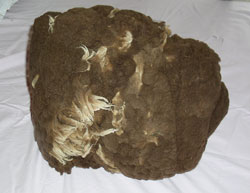
When I'm gloved, I spread the sheet out on the floor and dump the fleece onto it. This is the best way to sort fleece, because you can really see what you've got. If the fleece is nicely rolled up (as the one at left -- some shearers still do that), you can unroll it to reveal its original sheep shape; otherwise, just lay it out as well as you can.
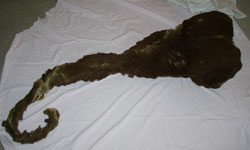
A fleece rolled in the traditional way will have the wool shorn from the neck area wrapped around the full bundle as a tie. When that's the case, that narrow strip will be the first part you'll unroll (left).
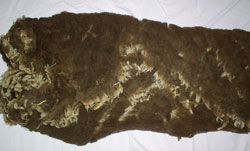
The next step in "unpacking" a traditionally rolled fleece is to unfold the main part of the body (left). It normally will be folded in thirds.
Depending on how fresh the fleece is, it may be more or less easy to see exactly how the fleece has been folded. Experienced shearers will always fold a fleece so that the cut ends of the wool face outward -- this elminates felting in transit.
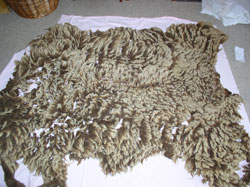
Your next assignment is to spread the fleece out into its original shape -- if you can. (It's not always possible.) This is helpful in several ways. First, if you want to sort the wool by length, you can do it by "zone", knowing that the wool near the edges of the fleece (corresponding to the belly, legs, and neck of the sheep) will be shorter than the full-length wool in the middle (which came from the sheep's shoulders and back). Second, when you know where the belly and leg areas are on the fleece, you'll know where to look for the "stuff" that you really want to remove.
With the fleece on the sheet, remove any big areas of vegetal matter (occasional straw and seed bits aren't a problem, but you want to get rid of big tangly messes), and also discard any chunks of "non-mud" and short, globby bits of wool. This is the "skirting" process, and the rule of thumb is simple: if you don't want to spin it, throw it out.
As you skirt, keep your eye open for little short bits of wool -- the "second cuts", created when the shearer goes back over the animal to tidy it up after shearing. These short bits are pretty easy to see -- they're about the size of a bay scallop, and they catch the light differently from the rest of the wool, so look like they're another colour. You want to remove them because (1) they can cause felting in the wash, and (2) they'll make weak spots in your yarn because their fibres are so short.
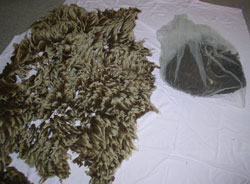
When you're done skirting, pick up a section of the fleece about 1 yard square or smaller (it will hold together, at least a little), give it a shake (to shake off chunks of straw and second cuts), and put it gently into the big net bag. Don't pack it down. Lift another bit of the fleece, shake it, and put it into the bag. Stop when the bag is between 1/3 and 1/2 full, and tie the bag shut with its strings (you don't have to tie it tight -- a bow will do).
Meanwhile, in the other room, fill the bathtub with hot water. As it fills, add a small amount of detergent -- "Dawn" liquid dish detergent is great if you have a particularly oily fleece, and more gentle liquid detergents will work, too. ...How much detergent? That depends on the fleece. If it's super-greasy, you'll need more; if it's not very oily, you'll need less. When it comes to detergent, it's probably best to err on the skimpy side. Too much of the stuff can make extra work in the rinsing cycle -- and it can also encourage felting.
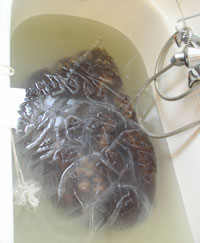
When the tub is full, shut off the water, then drop the net bag(s) into the bath. You can gently push them down to help them sink into the water, but don't move them around very much. (Agitation causes felting, a process in which the wool fibres fasten themselves onto each other. When you make felt on purpose, it's wonderful stuff -- but felted fibres can't be spun, and the process is not reversible.)
Let the bags of wool soak for about 15 minutes. At the end of that time, you can slowly push them from one end of the tub to the other, then back (a cheater's way of moving the water through the fibres), then gently lift the bags out of the water, set them aside (no squeezing or wringing!), and drain out the bathtub. The water at this point, by the way, will be surprisingly brown -- a lot browner than the water shown in this photo. That's normal. ;-)
Rinse the last of the dirty water from the tub, then refill it with hot water. When it's full, shut off the water and gently submerge the bags of wool in this rinse bath. Let them soak another 15 minutes. At the end of that time, slowly push them from one end of the tub to the other as you did before, then gently lift them out of the bath and set them aside.
If the water looks pretty clean at this point, you can move on to the next step. Chances are that it won't, though -- so drain the tub, refill it with hot water, and do another rinse soak.
Repeat the rinse cycle until you're satisfied with the cleanliness of the wool, as shown by the colour of the rinse water. When you've lifted the bags of wool out of their final rinse, you're ready to get the excess water out of the fleece -- the last step before drying. I usually set my bags onto a metal rack laid across the top of the tub and leave them there for a short while. That little "rest" on the rack lets a lot of the water drip out of the wool, so the bags are lighter-weight and easier to handle.
Gently place the bags of wet wool into the washing machine, close the lid, and run the "Spin" cycle. You want to make sure the washer doesn't spray water onto the wool during this cycle (that can cause felting!), so either verify that your machine won't do that, or just shut off the water supply while you spin the water out of the wool.
At the end of the "Spin" cycle, take the bags out of the washer, spread the wool out on some kind of rack to dry (sweater racks are super, but small. I often just lay my net bags across a metal laundry rack and use that), and wait. Avoid handling the wool while it's wet.
By the way, there's a thing I've noticed about water temperatures that I haven't seen documented anywhere: as long as the water you place the wool into is warmer than the water it just came out of, a change in temperature doesn't seem to cause any problems. ...That should take some of the anxiety out of the process for you. I haven't yet had a problem with temperature shock, as long as I've moved the wool into a warmer bath. (You do, however, want to avoid putting hot wool into a cool bath -- that will, indeed, cause problems worth crying over!).
Remember you can always test a small sample. If you're worried about your fleece and how well it will survive washing, just wash a test sample in the sink to see how it behaves in the water. You don't need to use up a lot of your wool to do this -- and seeing exactly what happens with the soap and temperatures you want can give you a lot of confidence in the washing process.
Above all, take courage -- despite all the things you've heard and read about washing fleece, it's not nearly as daunting a task as it might seem!
Go forth and wash that wool with calmness and conviction. :-)
Reading list
The following titles can give you more information and insight into various things mentioned in this article.
Diderot et d'Alembert. L'Encyclopˇdie -- Arts des Textiles.
A pictorial record of 18th-century French textile technology.
Cardon, Dominique. La Draperie au Moyen Age.
An amazing book on the medieval French wool industry. (In French)
Grierson, Su. The Colour Cauldron.
A wonderfully documented account of traditional dyeing practices in Scotland.
Teal, Peter. Hand Woolcombing and Spinning.
This is THE textbook on woolcombing and worsted spinning, covering all aspects in full detail.
Fournier, Nola and Jane. In Sheep's Clothing.
An excellent sourcebook on wool, with photos of fleece locks for each breed.
Ross, Mabel. The Encyclopedia of Handspinning.
Out of print, but still a great reference book.
Return to Articles page
